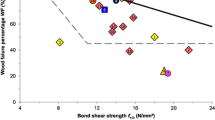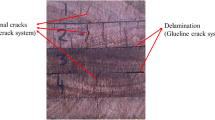Abstract
Unseasoned (green) spruce timber side boards of size 25 × 120 × 600 mm were flatwise-glued with a one-component PUR adhesive. Glued pairs of boards were then kiln-dried to 12 % moisture content. A special small-scale specimen for testing the fracture properties of the adhesive bond in Mode I was developed in order to evaluate the adhesive bond properties. The complete force versus deformation curve, including both the ascending and the descending parts, could be obtained with these small-scale specimens, enabling the strength and fracture energy of the bond line to be calculated. In addition, the fractured specimens were examined by scanning electron microscope. Results show that both the tensile strength and the fracture energy of the green glued PUR adhesive bonds were equal to those of the dry glued bonds. The methodology developed and used in the present study gives new possibilities for analysis of the mechanical behaviour of wood adhesive bonds, and particularly of their brittleness and its correlation with the type of fracture path. This is in sharp contrast to the use of standardised test methods (e.g. EN 302, ASTM D905) with specimens having relatively large glued areas. Using such types of specimens, it is not possible to obtain the complete force versus deformation response of the bond. In addition, when using such test methods, failure takes place in the wood or in the fibres near the bond, thus making it impossible to obtain detailed information about the bond line characteristics.









Similar content being viewed by others
References
Anon (ASTM D 905-898) Standard test method for strength properties of adhesive bonds in shear by compression loading. Adhesives, vol 15.06. ASTM, Philadelphia
Anon (EN 302-1:2004) Adhesives for load bearing timber structures. Test methods. Determination of bond strength in longitudinal tensile shear strength. European Committee for Standardization (CEN), Brussels
Baba MN (2011) Assessing the mode i interlaminar fracture toughness of wood laminated specimens—an experimental approach. Pro Ligno 7(3):10–17
Bergman RD, Simpson WT, Turk C (2010) Evaluating warp of 2 by 4 s sawn from panels produced through green gluing dimension lumber from small ponderosa pine logs. For Prod J 60(1):57–63
Boström L (1992) Method for determination of the softening behaviour of wood and the applicability of a nonlinear fracture mechanics model. Dissertation no TVBM-1012, Lund Institute of Technology, Division of Building Materials, Lund, Sweden
Conrad MPC, Smith GD, Fernlund G (2004) Fracture of wood composites and wood-adhesive joints: a comparative review. Wood Fiber Sci 36:26–39
Core Document of the COST Action E34 Bonding of Timber (2008) In: Dunky M, Källander B, Properzi M, Richter K, Van Leemput M (eds) WG 2 Green gluing. ISSN 1681-2808
da Silva LFM, de Magalhaes F, Chaves FJP, de Moura M (2010) Mode II fracture toughness of a brittle and a ductile adhesive as a function of the adhesive thickness. J Adhes 86(9):889–903
de Moura M, Oliveira JMQ, Morais JJL, Dourado N (2011) Mixed-mode (I plus II) fracture characterization of wood bonded joints. Constr Build Mater 25(4):1956–1962
Gagliano JM, Frazier CE (2001) Improvements in the fracture cleavage testing of adhesively-bonded wood. Wood Fiber Sci 33(3):377–385
Gustafsson PJ, Enquist B (1988) Strength of wooden beam at right angle notch. Report TVSM-7042, Lund Institute of Technology Division of Structural Mechanics (in Swedish)
Hilleborg A (1991) Application of the fictitious crack model to different types of materials. Int J Fract 51:95–102
Holmberg S (1998) A numerical and experimental study of initial defibration of wood. Dissertation No TVSM-1010, Lund Institute of Technology Division of Structural Mechanics, Lund, Sweden
Li Y-N, Bažant ZP (1994) Eigenvalue analysis of size effect for cohesive crack model. Int J Fract 66(3):213–226
Li S, Thouless MD, Waas AM, Schroeder JA, Zavattieri PD (2005) Use of Mode-I cohesive-zone models to describe the fracture of an adhesively-bonded polymer-matrix composite. Compos Sci Technol 65:281–293
Li S, Thouless MD, Waas AM, Schroeder JA, Zavattieri PD (2006) Competing failure mechanisms in mixed-mode fracture of an adhesively bonded polymer-matrix composite. Int J Adhes Adhes 26:609–616
Marzi S, Biel A, Stigh U (2011) On experimental methods to investigate the effect of layer thickness on the fracture behavior of adhesively bonded joints. Int J Adhes Adhes 31(8):840–850
Maun K, Cooper G (1999) Re-engineering softwood for constructional use by wet (green) gluing. In: Berti S, Macchioni N, Negri M, Rachello E (eds) Eurowood technical workshop proceedings industrial end-uses of fast-grown species, Florence May 31st–June 1st, pp 47–59
Ormstad E (2005) Gluing sideboards from green Norway spruce. In: Källander B (ed) Proceedings of international conference/workshop green gluing of wood—process—products—market, Borås, April 7–8, 2005, pp 113–117
Petersson H, Källsner B, Ormarsson S (2005) Shape stability of laminated planks made of green-glued pairs of side boards. In: Källander B (ed) Proceedings of international conference/workshop green gluing of wood—process—products—market. Borås, April 7–8, 2005, pp 118–124
Pommier R, Elbez G (2006) Finger-jointing green softwood: evaluation of the interaction between polyurethane adhesive and wood. Wood Mater Sci 1:127–137
Properzi M, Pizzi A (2003) Comparative wet wood gluing performance of different types of glulam wood adhesives. Holz als Roh- und Werkstoff 61:77–78
Seltman J (1995) Freilegen der Holzstruktur duch UV-Bestrahlung. Holz Roh Werkst 53:225–228
Serrano E (2000) Adhesive joints in timber engineering. Modelling and testing of fracture properties. Dissertation Report TVSM-1012, Lund University, Department of Mechanics and Materials, Structural Mechanics. Lund, Sweden
Serrano E (2001) Glued-in rods for timber structures. An experimental study of softening behaviour. Mater Struct 34(238):228–234
Serrano E (2004) A numerical study of the shear-strength-predicting capabilities of test specimens for wood-adhesive bonds. Int J Adhes Adhes 24(1):23–35
Serrano R, Cassens D (2001) Reducing warp and checking in plantation-grown yellow-poplar 4 by 4’s by reversing part positions and gluing in the green condition. For Prod J 51(11/12):37–40
Serrano E, Enquist B (2005) Contact-free measurement and non-linear element analyses of strain distribution along wood adhesive bonds. Holzforschung 59:641–646
Serrano E, Gustafsson PJ (2006) Fracture mechanics in timber engineering—strength analyses of components and joint. Mater Struct 40:87–96
Shipsha A, Berglund LA (2007) Shear coupling effects on stress and strain distributions in wood subjected to transverse compression. Compos Sci Technol 67:1362–1369
Simon F, Valentin G. (2000) In: Williams JG, Pavan A (eds) Damage and fracture of wood adhesive bonded joints under shear and opening loading, vol 27. European Structural Integrity Society, Elsevier, pp 285–296
Simon F, Valentin G (2003). In: Blackman RK, Williams JG, Pavan A (eds) Cohesive failure characterisation of wood adhesive joints loaded in shear, vol 32. European Structural Integrity Society, Elsevier, pp 305–316
Singh HK, Chakraborty A, Frazier CE, Dillard DA (2010) Mixed mode fracture testing of adhesively bonded wood specimens using a dual actuator load frame. Holzforschung 64(3):353–361
Sterley M (2004) Green gluing of wood. Licentiate thesis. KTH Stockholm, Sweden. ISBN 91-7283-711-X
Sterley M, Gustafsson PJ (2005) Shear fracture properties of green-glued polyurethane wood adhesive bonds. In: Frihart Ch R (ed) Proceedings No 7230 of wood adhesives 2005, pp 221–229
Sterley M, Serrano E, Enquist B (2008) Fracture characterisation of green glued polyurethane adhesive bonds in Mode I. In: Csiha C (ed) Proceedings of final conference in COST action E34 bonding timber; enhancing bondline performance, pp 156–166. Sopron, Hungary, 6–7 May
Sterley M, Serrano E, Enquist B (2009) Flat wise green gluing of Norway spruce for structural application. In: Proceedings of the international conference on wood adhesives, Lake Tahoe, Nevada, USA, September 28–30
Sterley M, Trey S, Lundevall Å, Olsson S (2012) Influence of cure conditions on the properties of a one component moisture cured polyurethane adhesive in the context of green gluing of wood. J Appl Polym Sci. doi:10.1002/app.36895
Stigh U, Alfredsson KS, Andersson T, Biel A, Carlberger T, Salomonsson K (2010) Some aspects of cohesive models and modelling with special application to strength of adhesive layers. Int J Fract 165(2):149–162
Veigel S, Follrich J, Gindl-Altmutter W, Müller U (2012) Comparison of fracture energy testing by means of double cantilever beam-(DCB)-specimens and lap joint testing method for the characterization of adhesively bonded wood. Eur J Wood Wood Prod 70(1–3):3–10
Wernersson H (1994) Fracture characterisation of wood adhesive joints. Dissertation TVSM 1006. Lund Institute of Technology Division of Structural Mechanics, Sweden
Xavier J, Morais J, Dourado N, de Moura M (2011) Measurement of Mode I and Mode II fracture properties of wood-bonded joints. J Adhes Sci Technol 25(20):2881–2895
Acknowledgments
The financial support from the Foundation Centre for Building and Living with Wood (CBBT) and from the Knowledge Foundation (KK-stiftelsen), which made this research possible, is hereby gratefully acknowledged.
Author information
Authors and Affiliations
Corresponding author
Rights and permissions
About this article
Cite this article
Sterley, M., Serrano, E. & Enquist, B. Fracture characterisation of green-glued polyurethane adhesive bonds in Mode I. Mater Struct 46, 421–434 (2013). https://doi.org/10.1617/s11527-012-9911-5
Received:
Accepted:
Published:
Issue Date:
DOI: https://doi.org/10.1617/s11527-012-9911-5




